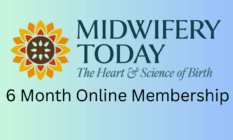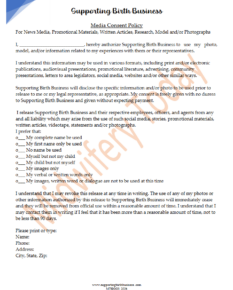
The Flowering of Midwifery Education
Editor’s note: This article first appeared in Midwifery Today, Issue 78, Summer 2006.
Join Midwifery Today Online Membership
Having just returned from the beauty of Costa Rica, “pura vida,” my eyes are opened to simplicity in lifestyle, communication and appreciation of life around me. My experiences when I travel there are typically of coming wide awake, as I let go of tension, mistrust, anxiety and alienation that are so much a part of life in the US. As I consider the topic of midwifery education, I want to use this beauty lens to help me see more clearly what is needed. How can we shape education that cultivates openness, simplicity and appreciation for all life?
We certainly have come a long way in our journey to find ways to educate ourselves: from the self-starting days to study groups, intensives, courses, and now, formal programs. The Midwifery Education Accreditation Council (MEAC) undertook the formidable task of creating an accreditation process that would honor and preserve a variety of educational routes, especially apprenticeship, and has largely succeeded. And yet, the stories come through from time to time, and with increasing frequency, of this midwife or that behaving most unwisely, or from a place of fear, arrogance or detachment. Some of the behaviors and decisions made by these midwives have prompted me to say, “But that’s not midwifery…” Or even, “How could a midwife do that?”
I remember a most shocking moment while attending a workshop several years ago at a Midwifery Today conference in London. The topic was sexuality, and the attendees were mostly doulas and childbirth educators. The presenter related the story of her sister’s birth in hospital and said (without blinking) that the brutality of the midwife had led to a damaging experience. I had never heard the words brutality and midwife in the same sentence and found the experience eye-opening. Apparently we cannot assume that a midwife is a women-centered practitioner, or a client advocate or even a sensitive person, let alone spiritually aware.
Thankfully, we have guidelines for our professional identity in the Midwifery Model of Care. And we have the MANA Core Competencies, Standards of Practice, and Values and Ethics Statement—beautiful documents developed by consensus. We have done a great job of articulating our ideals. But when those ideals do not manifest in practice, we have to ask why. Is it just the occasional bad apple that slips through the system, or is it an otherwise good care provider worn down by the rigors of practice, the intimidation of the medical establishment or the isolation of going against the grain? Whatever it is, we need to ask whether our educational models are adequately preparing midwives for their work in the world. Perhaps our models need revising or updating.
I have long maintained that the only midwifery program worth its salt is one that midwifes the student into her full potential, just as we do birthing women. If we tell our mothers to surrender to fear, to trust and let go, to take a leap of faith, to have courage, to dream the beauty of their birth into being, we as midwives must have the capacity for the same. Any experienced midwife will tell you that being comfortable in the “big space,” the feminine field, the Beauty Way, is at the heart of this work. A midwife’s access to the ground of being, the source, is her greatest offering to clients.
Robbie Davis-Floyd, Marilyn Ferguson and others have taught us that the midwifery model and medical model reflect different paradigms—not just distinct from one another, but diametrically opposed in most respects. To take an example—medicine views the body as a machine; midwifery views it as a system involving thought, feeling and spirit. Can you recall points in your midwifery education where the body-as-machine view was presented? Or did the structure of your curriculum support such a view, by separating anatomy and physiology from an integrated, whole-person approach?
To take this a step further, if it is true that we are what and how we learn, what are the impacts on the student (and the midwife she will become) of studying body-as-machine? Potential impacts on her clientele are obvious; less so are impacts on her personally. But think about it—if you hold the body-as-machine view, you might tend to push yourself, not listen to your instincts or your intuitions. You probably wouldn’t make time for reflection and rest a priority, thinking only of priming your machine to top performance. The locus of your faith and trust reside outside yourself, in the belief that this or that treatment will lead to wellness—not, as with the integrated whole-person view, that the remedy resides within and along with the locus of power.
Another critical difference between medical and midwifery models emerges with the concept of clinical detachment. The medical paradigm maintains that clinical detachment is not only desirable but imperative; the midwifery model recognizes that caregiving is a relationship between client and provider. So the question arises—how well are we teaching our students the art of relationship? Is self-assessment—not just as a student, but also as a person—part of the curriculum from the very start? Is honest communication actively encouraged every step of the way? If not, how can we expect students to have the confidence, clarity and openness to stand against a dominant system that says these things don’t count? A midwife in touch with herself, humble and true, could never be brutal, smug or self-serving. And she would know her limits, when to seek advice or support and how to ask for it—absolute essentials for safe practice.
When I recall my formal education, I rarely had a teacher who helped me peel off the layers to find this beauty and strength. Mostly I was taught by instructors attached to deep cover, who expected me to collude with the illusion that we were being open and wise. But we midwives know the difference between covering up and peeling off, loosening, letting go—birth language that needs to become our language of education.
The more we learn about the nature of reality, of the truth that our thoughts create form and manifest physically, the less whimsical it seems to emphasize the inner training of the midwife—the clearing of biases, the opening of the heart, the slowing down to receive information, the means to be highly alert and yet fully relaxed at the same time in the state most conducive to clear thinking and intuition.
Flowering is the result of good seed and good soil, continued nourishment and cultivation, and the natural course of events that brings growth to fruition.
The flowering of midwifery education is in the opening, the grace, the surrender, the beauty and the union with what is great and good, and the strength that comes with this. The strength that comes with this. What things make you strong in this way? How can we make sure that every student in our tutelage/care is supported and assisted in making these discoveries for herself?
Overview of National Midwifery Institute, Inc.
Challenge Program for California Midwifery Licensure
National Midwifery Institute, Inc. (NMI), offers a three-year, distance-learning program which is unique in that students receive an integrated overview of midwifery art and practice (with sciences woven in) at the outset, to which they add in-depth, topical studies concurrent with apprenticeship.
As an instructor and co-director of NMI, I am happy to announce that after several years in the works, our challenge process for California licensure has been approved by the California Medical Board. We are especially pleased in that it incorporates the CPM portfolio process and credential, upholding our commitment to apprenticeship and student-driven learning.
Successful completion of the NMI Challenge Program provides access to California licensure for midwives who have completed their clinical training and study and wish to qualify without graduating from an approved three-year program.
The NMI Challenge Program for California Midwifery Licensure has four parts:
- Enrollment with National Midwifery Institute
Students apply and enroll with National Midwifery Institute. Students already enrolled in NMI who have completed NMI clinical experience requirements may opt to complete the NMI Challenge Program instead of completing the three-year program for graduation. - Completion of clinical experience requirements
National Midwifery Institute requirements for clinical experience include the following:- 20 new antepartum visits
- 75 return antepartum visits
- 20 labor management experiences
- 20 deliveries
- 40 postpartum visits, within the first five days after birth
- 20 newborn assessments
- 40 postpartum/family planning/gynecology visits
At least half of all experience must be within five years preceding graduation or of completing the NMI Challenge Program. Students pursuing the NMI Challenge Program must qualify for and pass the NARM Skills Assessment prior to sitting the NMI Challenge Program Written Examination.
Application to NARM and related fees are the responsibility of the student.
Students who have earned their NARM CPM credential prior to enrolling with NMI must also demonstrate completion of NMI clinical experience requirements. - Verification of clinical experience
As per California law, students pursuing the NMI Challenge Program must have their clinical experience documentation verified by a licensed physician/surgeon and a licensed midwife or certified nurse-midwife. Students are responsible for making arrangements with verifiers. Verification is documented and submitted to NMI. - Passing the NMI Challenge Program Written Examination
Students qualify to take the NMI Challenge Program Written Examination upon successful completion of NMI clinical experience requirements, experience verification and NARM Skills Assessments.
The NMI Challenge Program Written Examination is offered twice each year: at the CAM conference in Spring and in October (at a date to be determined each year).
Upon passing the NMI Challenge Program Written Examination, students have completed the NMI Challenge Program for California Midwifery Licensure. Formal notice of completion is provided to the student and to the Medical Board of California.
For an application or more information, contact NMI Administrator Shannon Anton at [email protected], (802) 453-3332, or write NMI, P.O. Box 128, Bristol, VT 05443.

 Elizabeth Davis, CPM, is a renowned expert on midwifery and reproductive health issues. She has been a midwife, reproductive health care specialist, educator, and consultant since 1977. She is internationally active in midwifery education/legalization, and she lectures widely on reproductive rights, sexuality, and birth trauma. She served as regional representative to the Midwives Alliance of North America (MANA) for five years and as president of the Midwifery Education Accreditation Council (MEAC). She is co-founder of the National Midwifery Institute, Inc., a MEAC-accredited, apprenticeship-based midwifery program leading to licensure in California and the CPM credential. She holds a degree in Holistic Maternity Care from Antioch University and is certified by the North American Registry of Midwives. She is the author of the classic
Elizabeth Davis, CPM, is a renowned expert on midwifery and reproductive health issues. She has been a midwife, reproductive health care specialist, educator, and consultant since 1977. She is internationally active in midwifery education/legalization, and she lectures widely on reproductive rights, sexuality, and birth trauma. She served as regional representative to the Midwives Alliance of North America (MANA) for five years and as president of the Midwifery Education Accreditation Council (MEAC). She is co-founder of the National Midwifery Institute, Inc., a MEAC-accredited, apprenticeship-based midwifery program leading to licensure in California and the CPM credential. She holds a degree in Holistic Maternity Care from Antioch University and is certified by the North American Registry of Midwives. She is the author of the classic 



















